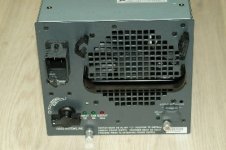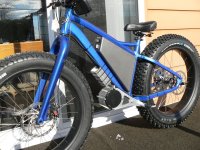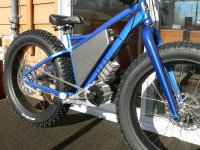gbeals said:
Hello Gents - I hope you don't mind me jumping into this thread. I'm behind you in progress on the Trials bike, but very deep into my research. I had the pleasure of demoing the 2020 Electric Motion bike here in the Jungle's of Hawaii. (My back yard) I rode both the escape and the e-pure Race Trials bike. I first will say the thing is a BEAST! BEAST!!!! I will say.... I'm an experienced motorcycle rider, super bikes, harley, bobbers, dirt, supermoto - but new to Trials bike. So I can't come close to a trials rider but I have something to offer this conversation regarding the electric vs hydraulic clutch.
I TRIED to use it and then gave up quite quickly. It is definitely not needed and felt silly from a typical stop. Rolling on the throttle lifted the bike in the lightest map (there are 3 maps). I then thought let's try to dump the clutch some and see what happens - Like in trials. It made a cool noise and then BOOM - bike flew up as I expected it to. It's light and I'm no trials rider, so I'd expect you could do some pretty sizable hops with all that torque. My next test - Crack the throttle violently. Almost felt the same. The power delivery was faster of course when you dump - I enjoyed the electronic clutch just as much - but a little more as it served a dual purpose. One setting was for Electronic clutch the other was for regeneration. I like the regen on steep hills - used as engine braking and generated plenty of recharge.
MAPS - I cranked the bike up the the 3rd - supposed to simulate a 300cc bike. YUP. I think so. It hit the mark for me. I did find it was just too much power in the woods. Maybe for a PRO Trials rider, but not for me. I found 1 and 2 maps climbed anything i tossed at it, and was the most responsive (sometime too responsive) map. I design applications and mobile apps so looking forward to diving into the controller and seeing what I can do there.
I would buy one - however I know how much they cost. I am a fabricator and love to build things and can do this at a fraction of the costs. So I will build my own. I dug into the bike a little and can see the bulk of the parts and you folks have already mentioned them within this thread. I know the 2019 EM used 5KW BLDC Motor - HPM5000B from Goldenmotor- I think the 2020 uses the same. I'm not sure if it is liquid or air cooled - but I will find out soon.
I have already learned quite a bit from reading this thread and look forward to more. I'm new to electricity so that is where my learning curve is. I haven't quite figured out all the math; which is why I started to figure out what EM has, and just go from there.
The more the merrier!
The cost of the EM was what also sent me down this path, I then took the left fork down the Fat-E trials bike path.
I'll point you to the "
Trials riders need their clutch?" thread, it might help shed some light on the pros and cons of clutches for trials. You can certainly ride trials and have plenty of fun without a clutch (see Altair's comments about having more fun on his clutchless fat bike than he possibly ever had on his clutch equipped ICE bikes), but I'm absolutely convinced there are very common trials maneuvers that you simply cannot really do without a clutch. Just depends if you
want to do those things. If you can, get a bit of time on trials bikes (ideally with someone who knows how to ride trials) so you get clear what it is you want to do with it - single track weapon? Technique development? Trials comps? Mucking about silently in the back yard?
I'd also say that most motorcycle riders coming into trials soon discover that the skills they thought they had are considerably short of what's required for even quite modest trials. Be prepared for a pretty steep (but very rewarding) learning curve if you really want to ride trials.
As for the regen thing, that's no big deal to solve - I'm planning on fitting a left hand thumb throttle for regen braking. Just one way of tackling the problem.
I can't comment on the electric experience vs ICE as I'm still slowly working on my build and don't expect it to be ready for some months yet. I'd love to have a ride on the ePure but I've never seen one anywhere near my neck of the woods, only the earlier model.
I've been an industrial designer of over 30 years, and worked for a micro hydro company for some years developing turbines and aspects of one of their alternators, so learnt a bit about electrics. I've also worked a bit with PLC's and some very basic electronic circuits. Despite that the amount I've had to pickup for this project has been huge. Just the myriad little (and big) things like which connectors to use, how to reasonably safely construct and manage a LiPo battery, which cells to use, where to source a suitable power source for charging ... the list just goes on! Certainly drawing from the EM components list will reduce a lot of those issues. I expect your battery will be the most effort to sort through and get built.
I'd suggest buying a trials bike from about 2005 on, and grafting an electric into it. 125, 250, 300 - makes no difference, they all share the same geometry and components. All the current brands are good, each has it's strengths and weaknesses, but there aren't any duds and it'll probably be hundreds of hours before you out-ride any of them. That's a reasonably well trodden path that works pretty well from what I've seen. Some people keep the gearbox, others don't.
I'm not sure which controller the EM is using now, they used to use Kelly but I seem to recall the latest ones use a different controller? Kelly don't seem to be highly thought of here, but they obviously work well enough. Probably a good choice to go with whatever EM use, although I'd hazard a guess that reliable, production grade supply and support is possibly a bigger decider for them than absolute best performance. The Nucular controllers seem on balance to be the current cream of the crop for a variety of reasons, although you pay a signifcant premium over the more common Chinese controllers.
When I was looking at building an electrified moto trials bike it looked pretty hard to go past the QS motors for cost and performance - people are easily driving the 3kw mid motor to 15-18kw! How their low speed torque compares to the Golden is a bit of an unknown, to me at least. Torque is king on a trials bike, outright power is almost irrelevant. Much of what you'll read on ES forums talks about power and speed - from what I've learnt here, that's got only marginal relevance to what we need. A motor that's happy putting out big power at high speed can overheat in seconds when being asked to put out a load of torque close to stall. I know the GasGas electric uses a liquid cooled motor - can't recall for the EM or the Dragonfly.
I'd be interested to see the full component list for the EM if you put that together.





